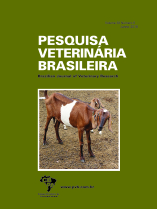 |
|
|
|
Year 2018 - Volume 38, Number 6
|

|
Hematological and biochemical indicators of maturity in foals and their relation to the placental features, 38(6):1232-1238
|
ABSTRACT.- Feijó L.S., Curcio B.R., Pazinato F.M., Almeida B.A., Moraes B.S.S., Borba L.A. & Feijó J.O. & Nogueira C.E.W. 2018. Hematological and biochemical indicators of maturity in foals and their relation to the placental features. [Indicadores hematológicos e bioquímicos de maturidade em potros e relação com suas características placentárias.] Pesquisa Veterinária Brasileira 38(6):1232-1238. Departamento de Clínica Veterinária, Universidade Federal de Pelotas, Campus Universitário, Capão do Leão, RS 96160-000, Brazil. E-mail: curciobruna@hotmail.com
Newborn’s health is directly related to gestational conditions and placental efficiency. The aims of this study were: (1) To evaluate hematological and biochemical parameters of foals born from mares with placentitis at birth and at 24h of age, (2) to verify if placental pathology had any influence on neonatal maturity degree through hematological and biochemical response of those foals. According to placental findings (control and placentitis) and neonatal maturity degree (mature and immature), foals were divided into three groups: (1) Control group (n=22), foals born from mares with placentitis and classified as (2) Mature (n=26), and (3) Immature (n=10). The hematocrit and plasma concentration of fibrinogen, total plasma protein, white blood cells count, lactate, glucose, creatinine, urea, albumin, bilirubin, triglyceride, cholesterol, calcium, phosphorus, magnesium, aspartate aminotransferase (AST), creatine kinase (CK), alkaline phosphatase (ALP), and gamma-glutamyltransferase (GGT) were measured. Placental features were significantly different between neonatal maturity degree (P=0.001). Mares that had acute placentitis foaled more immature neonates (n=8/10; 80%). Concentrations of fibrinogen (P=0.003), creatinine (P=0.021), total cholesterol (P=0.014), AST (P=0.001), GGT (P=0.002), total (P=0.001) and unconjugated bilirubin (P=0.010) were higher at birth in the Immature group, whereas albumin levels were lower (P=0.002). Foals born from mares with placentitis presented hyperlactatemia at 24h of age (P=0.002). Acute placentitis had an influence on the neonatal maturity, allowing an accelerated but incomplete fetal maturation. The monitoring of lactate, fibrinogen, creatinine, bilirubin, cholesterol, albumin, AST, and GGT levels, associated with clinical, physical, and behavior evaluation may contribute as indicators of neonatal maturity. |
| |
|
|
| |
|
 |